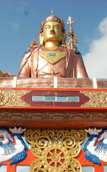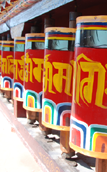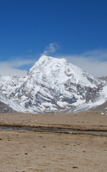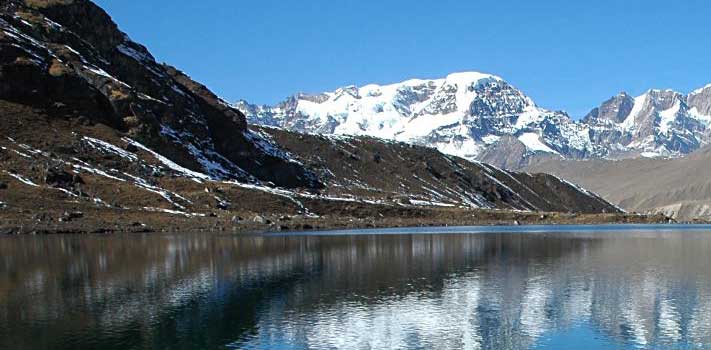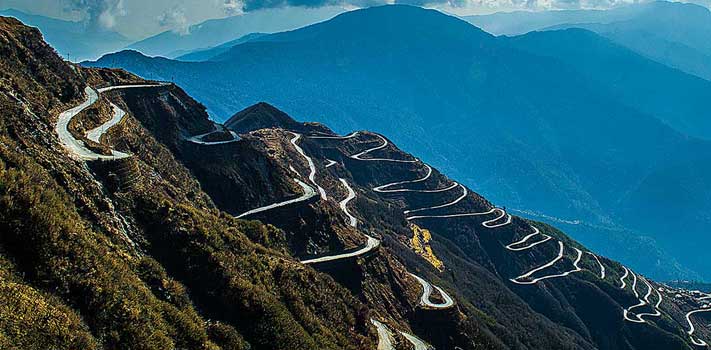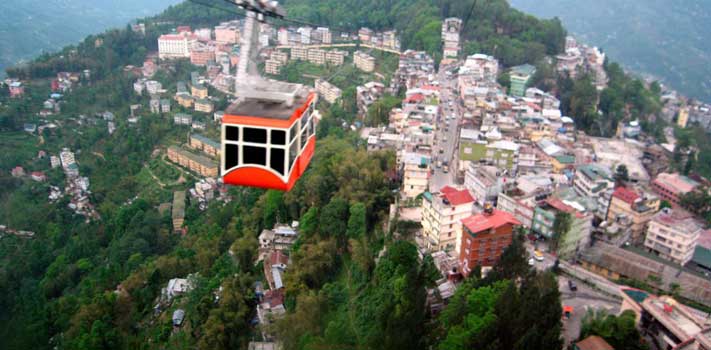About Sikkim
- Nestled in the Himalayas and endowed with exceptional natural resources, Sikkim is a hotspot of biodiversity and development. The state borders Nepal to the west, China’s Tibet Autonomous Region to the north and east and Bhutan to the southeast. The Indian state of West Bengal lies to the south. Sikkim is situated at the foot of Mount Kanchendzonga and boasts of an unexplored beauty. Known to outside world as Kanchenjunga, it is the third highest peak in the world. But to the Sikkemese it is the Guardian deity, a country God whose benign watchfulness ensures peace and prosperity for the land. The five peaks of Khangchendzonga are the five Treasures of the Eternal Snow, a belief beautifully interpreted by the great Lama Lhatsun Chenpo: “The peak most conspicuously gilded by the rising sun is the treasury of gold, the peak that remains in cold grey shade is the storehouse for silver and other peaks are vaults for gems, grains and the holy books.” Each of the five peaks is believed to be crowned by an animal—the highest by a tiger and others by a lion, elephant, horse and the mythical bird Garuda. Along with the Guardian deity, the Nepal Peak, Tent Peak, Pyramid, Jonsang, Lhonak, Pahunri etc. and glaciers like Zemu, Changsang, Teesta, Changme are also important.
- With around 607,000 inhabitants as of 2011, Sikkim is the least populous state in India and the second-smallest state after Goa in total area, covering approximately 7,096 km2 (2,740 sq mi). Sikkim is nonetheless geographically diverse due to its location in the Himalayas; the climate ranges from subtropical to high alpine, and Kangchenjunga, the world’s third-highest peak, is located on Sikkim’s border with Nepal.[3] Sikkim is a popular tourist destination, owing to its culture, scenery and biodiversity. It also has the only open land border between India and China. Sikkim’s capital and largest city is Gangtok.
- According to legend, the Buddhist saint Guru Rinpoche visited Sikkim in the 8th century AD, introduced Buddhism and foretold the era of the monarchy. Sikkim’s Namgyal dynasty was established in 1642. Over the next 150 years, the kingdom witnessed frequent raids and territorial losses to Nepalese invaders. In the 19th century, it allied itself with the British rulers of India, but was soon annexed by them. Later, Sikkim became a British protectorate, before merging with India following a referendum on abolishing the monarchy in 1975.
- Sikkim is the only state in India with an ethnic Nepali majority. Sikkim has 11 official languages. English is taught in schools and used in government documents. The predominant religions are Hinduism and Vajrayana Buddhism.
- Yuksom:
This was the first capital of Sikkim and the base camp for trek to the famous Mt. Khangchendzonga. The historical records say that the first divine ruler of Sikkim was sanctified in 1641 by the three learned lamas. The evidence of the ceremony is still present in Norbugang Chorten. The place is considered sacred since the history of Sikkim began from here. It’s also the base camp for the trek to the famous Mt. Khangchendzonga. - Tsomgo Lake:
The lake is about a kilometer long, oval in shape and is considered very holy by the locals. Between May to August, the lake area is spectacular with a display of rare flowers including the primulas, iris and blue & yellow poppies. The lake has a number of aquatic and aerial species and is a perfect habitat for the red panda. The lake freezes in winter. - Nathula Pass:
The pass at an altitude of 14200 ft, is located on the Indo-China border and connects Sikkim to Tibet Autonomous Region in China. The journey itself is an exhilarating experience, with mist covered peaks, zigzag roads and roaring waterfalls, the passage is simply amazing. Visitors are required to get a permit to visit the place. - Pelling:
At an altitude of 6800 ft, it’s the most excellent place to get a closest view of the world’s 3rd highest peak Mt. Kanchendzonga. Apart from the innate beauty of the place, other attractions in Pelling are the Sanga Choeling Monastery, Pemayangtse Monastery and the Khecheopalri Lake. - The Rumtek Monastery:
This magnificent monastery is among the top tourist attractions in Sikkim. It provides as a residence for the 16th Gyalwa Karmapa. The Monastery features some of the extraordinary works of art. The Golden Stupa is the most significant segment of the monastery. - Do-Drul Chorten:
Built by the head of Nyingma order of Tibetan Buddhism in 1945, it has one of the most beautiful Stupas of Sikkim consisting of 108 prayer wheels. It stores various Mandala sets, a set of relics and some other religious possessions. Statues of Gurus are also present there. - Jawaharlal Nehru Botanical Garden:
Established in 1987 the Jawaharlal Nehru Botanical Garden is situated near Rumtek Monastery and is looked after by the Forest Department of the Sikkim Government. The garden is distinguished by enchanting lush woodlands of Oak, different kinds of trees and orchids.
Sikkim Research Institute of Tibetology: It is a nationally well known centre of Tibetan Studies & Research. The institute is renowned for its huge collection of rare manuscripts, Buddhist books and icons. The building is an excellent example of Tibetan architecture, surrounded by small forests of oak and birch trees. The institute also houses religious works of art and amazing silk embroidered paintings.
